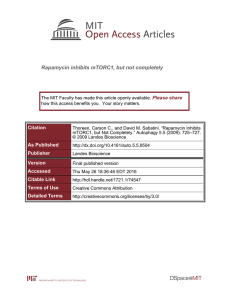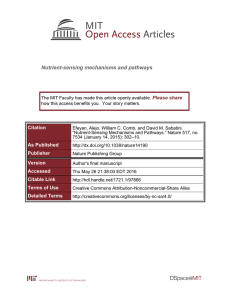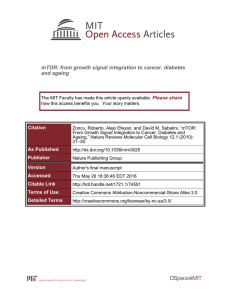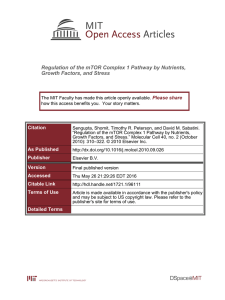The TASCC of Secretion Please share
advertisement
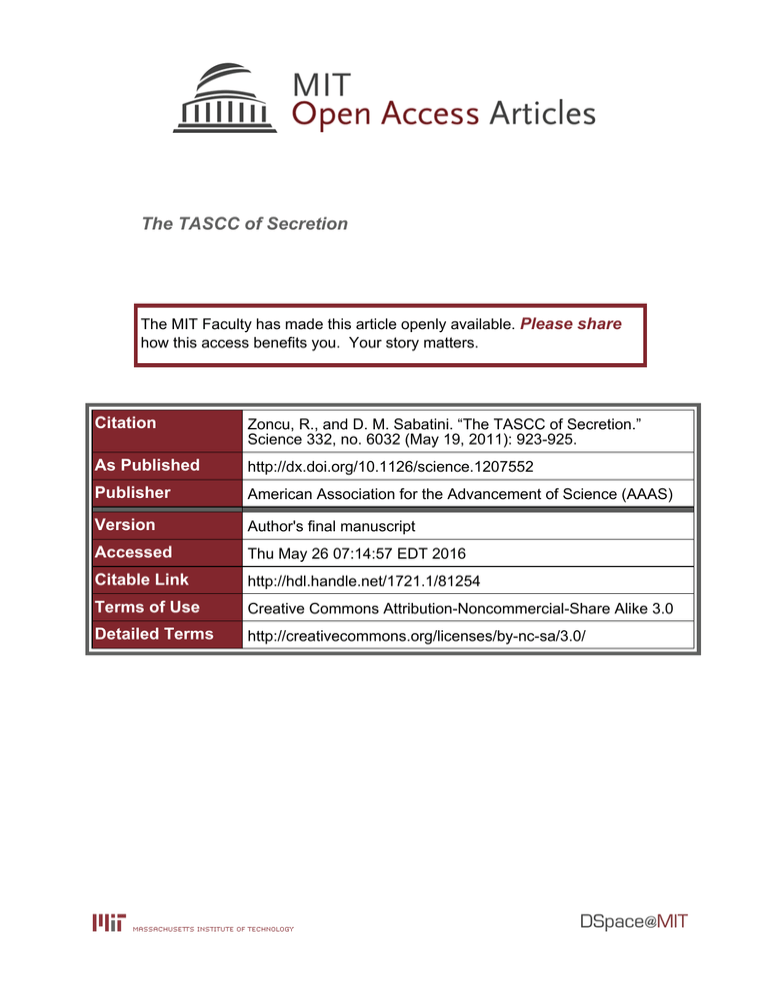
The TASCC of Secretion The MIT Faculty has made this article openly available. Please share how this access benefits you. Your story matters. Citation Zoncu, R., and D. M. Sabatini. “The TASCC of Secretion.” Science 332, no. 6032 (May 19, 2011): 923-925. As Published http://dx.doi.org/10.1126/science.1207552 Publisher American Association for the Advancement of Science (AAAS) Version Author's final manuscript Accessed Thu May 26 07:14:57 EDT 2016 Citable Link http://hdl.handle.net/1721.1/81254 Terms of Use Creative Commons Attribution-Noncommercial-Share Alike 3.0 Detailed Terms http://creativecommons.org/licenses/by-nc-sa/3.0/ NIH Public Access Author Manuscript Science. Author manuscript; available in PMC 2012 July 05. NIH-PA Author Manuscript Published in final edited form as: Science. 2011 May 20; 332(6032): 923–925. doi:10.1126/science.1207552. Cell Biology: the TASCC of secretion Roberto Zoncu1,2,3 and David M. Sabatini1,2,3,4 David M. Sabatini: sabatini@wi.mit.edu 1Whitehead Institute for Biomedical Research, 9 Cambridge Center, Cambridge, MA 02142, USA 2Department of Biology, Massachusetts Institute of Technology, Cambridge, MA 02139, USA 3The David H. Koch Institute for Integrative Cancer Research at MIT, 77 Massachusetts Avenue, Cambridge, MA 02139, USA 4Howard Hughes Medical Institute NIH-PA Author Manuscript The senescence state induced by the oncogenic activation of the p53 and retinoblastoma (pRb) pathways is likely an important mechanism for preventing the proliferation of potential cancer cells (1, 2). Senescent cells exit the cell cycle and undergo major changes in chromatin structure that are thought to render senescence irreversible. Despite the absence of proliferation, senescent cells are not as quiescent as first thought, as they signal to their surrounding environment by activating a secretory program (3, 4). On page xx of this issue, Narita et al provide evidence that in order to enable this secretory state, senescent cells must profoundly reorganize their endomembrane system. The secretory program leads to the massive production of factors [collectively termed the senescence messaging secretome (SMS) or senescence associated secretory phenotype (SASP)] that are released into the surrounding microenvironment (3, 4). The composition of the SMS is heterogeneous, as it includes growth factors, inflammatory cytokines, and modulators of the extracellular matrix, and its precise physiological role is highly controversial. For example, inflammation can modify the microenvironment in ways that favor invasion and tumor growth (5, 6); however, in the context of oncogene-induced senescence, inflammatory cytokines also appear to exert an autocrine, tumor-suppressive action (7–10). NIH-PA Author Manuscript Narita et al find that H-RasV12-induced senescence triggers a reorganization of the endomembrane system of senescent cells, which results in the formation of a novel membrane compartment that carries out the SMS. Narita et al name this novel structure the ‘TOR-Autophagy Spatial Coupling Compartment’, or TASCC. As the name suggests, the key ingredients of this compartment are autophagosomes and the mTOR Complex 1 (mTORC1) kinase. In the proposed model autophagosomes, by degrading aged organelles and proteins, generate a high flux of amino acids and other metabolites that provide building blocks for biosynthesis (11). mTORC1 promotes the utilization of these metabolites for the synthesis of the SMS components. The secret to this highly efficient process resides, according to the authors, in the tight spatial coupling of autophagy and mTORC1; in cells undergoing RIS, they find a large accumulation of mTORC1-studded lysosomes together with autophagosomes in a well-defined perinuclear location. In support of their model, Narita et al find that blocking the localization of mTORC1 to the TASCC via knock down of the Rag GTPases (which recruit mTORC1 to the lysosomal surface in response to amino acids (12)) results in a strong reduction in the synthesis and secretion of two key SMS components, IL6 and IL8. Moreover, blocking autophagy, and thus cutting off the amino acid supply that activates mTORC1, leads to complete loss of mTORC1 from the TASCC. Zoncu and Sabatini Page 2 NIH-PA Author Manuscript While bringing together autophagy and mTORC1 seems like a smart way to increase the secretory output of cells, it also poses a logical problem; activated mTORC1 is a potent suppressor of autophagy, via its ability to phosphorylate and inhibit key autophagy initiators, including the ULK1 kinase (11). In fact rapamycin, an inhibitor of mTORC1, induces autophagy even when cells are in a nutrient-rich environment. In order to explain this apparent paradox, the authors analyze the subcellular distribution of epitope-tagged ULK1 and, interestingly, find that it appears to be excluded from the TASCC. Moreover, using a ‘traffic light’ reporter of autophagosome maturation, they observe that the TASCC mainly contains mature autophagosomes, while early autophagosomes are mostly outside the TASCC. Thus, in senescent cells, autophagosomes form outside the TASCC, out of reach from the inhibitory action of mTORC1, but they progressively move inward as they mature. This finding has broad implications, as it suggests that spatial segregation of mTORC1 from autophagy-initiating factors may enable the maintenance of basal autophagy in actively growing cells. NIH-PA Author Manuscript Supporting a key role for the TASCC in driving the secretory activity of senescent cells, ultrastructural analyses reveal a close apposition of the TASCC with elements of the endoplasmic reticulum, Golgi apparatus, and trans-Golgi network. Moreover, Narita et al use click chemistry to label nascent polypeptides and follow their fate; they find that newlysynthesized proteins are enriched in the TGN within 30 minutes of their synthesis, but accumulate in the TASCC shortly afterwards. Thus, a continuous flow of newly-synthesized proteins traverses the secretory pathway and ends up in the TASCC; this extremely rapid protein turnover may be key in fueling the synthesis of SMS components. A key unanswered issue is whether senescence upregulates the activity of the secretory pathway as a whole, or whether it selectively boosts the translation and secretion of the SMS components alone. The high rate of protein turnover, together with the elevated autophagic activity, suggests a scenario where the synthesis of many protein species may be nonselectively upregulated during RIS; however, most of these proteins would be destined for immediate degradation, while only SMS components would be selectively secreted. This seemingly wasteful mechanism may underlie a broader function for the TASCC in nonsenescent physiological settings; in fact, Narita et al identify TASCC-like structures in leukemia cells undergoing differentiation, as well as in renal glomerular cells in vivo. Thus, it is conceivable that multiple mechanisms could set up the TASCC and enhance general secretory activity, but the nature of the proteins being stabilized and secreted may be context-specific. NIH-PA Author Manuscript In conclusion, Narita et al reveal the surprising ability of senescent cells to reorganize the morphology and the function of their endomembrane system. Their findings bring forth some exciting questions; in particular, what are the mechanism(s) that lead to formation of the TASCC? Are there senescence-associated gene expression programs that control membrane organization and dynamics? Are H-Ras and/or p53 directly involved? Answers to these questions are likely to shed light on the role of the TASCC in the maintenance of the senescent state and in tumor suppression. References 1. Courtois-Cox S, Jones SL, Cichowski K. Oncogene. May 1.2008 27:2801. [PubMed: 18193093] 2. d’Adda di Fagagna F. Nat Rev Cancer. Jul.2008 8:512. [PubMed: 18574463] 3. Kuilman T, Peeper DS. Nat Rev Cancer. Feb.2009 9:81. [PubMed: 19132009] 4. Rodier F, Campisi J. J Cell Biol. Feb 21.192:547. [PubMed: 21321098] 5. Coppe JP, et al. PLoS Biol. Dec 2.2008 6:2853. [PubMed: 19053174] 6. Hanahan D, Weinberg RA. Cell. Mar 4.144:646. [PubMed: 21376230] Science. Author manuscript; available in PMC 2012 July 05. Zoncu and Sabatini Page 3 NIH-PA Author Manuscript 7. Acosta JC, et al. Cell. Jun 13.2008 133:1006. [PubMed: 18555777] 8. Kortlever RM, Higgins PJ, Bernards R. Nat Cell Biol. Aug.2006 8:877. [PubMed: 16862142] 9. Kuilman T, et al. Cell. Jun 13.2008 133:1019. [PubMed: 18555778] 10. Wajapeyee N, Serra RW, Zhu X, Mahalingam M, Green MR. Cell. Feb 8.2008 132:363. [PubMed: 18267069] 11. He C, Klionsky DJ. Annu Rev Genet. 2009; 43:67. [PubMed: 19653858] 12. Sancak Y, et al. Cell. Apr 16.141:290. [PubMed: 20381137] NIH-PA Author Manuscript NIH-PA Author Manuscript Science. Author manuscript; available in PMC 2012 July 05. Zoncu and Sabatini Page 4 NIH-PA Author Manuscript Figure 1. The TASCC enhances synthesis and secretion of SMS components during Ras-induced senescence NIH-PA Author Manuscript In normal cells growing in nutrient-rich medium (left) autophagy is suppressed, among other mechanisms, by mTORC1-mediated phosphorylation of ULK1. In cells undergoing Rasinduced senescence (right), massive autophagosome formation initiates at the cell periphery (A). This may be due to the massive recruitment of mTORC1-positive lysosomes in the vicinity of the nucleus (B), resulting in de-inhibition of ULK1 at more distal locations. As autophagosomes mature, they fuse with mTORC1-positive lysosomes, giving rise to the TASCC (B). The flow of amino acids and other metabolites from autophagolysosomes activates mTORC1 (C), and also provides basic building blocks for protein synthesis. As a consequence, production of SMS components is upregulated at the endoplasmic reticulum and Golgi apparatus (D). Finally, SMS components are packaged into secretory vesicles at the trans-Golgi network and sent toward the plasma membrane (E); however, some newlysynthesized proteins are re-routed to the TASCC and rapidly degraded to fuel further rounds of protein synthesis. Abbreviations: TASCC = TOR-Autophagy Spatial Coupling Compartment; ER = endoplasmic reticulum; GA = Golgi apparatus; TGN = trans-Golgi network. NIH-PA Author Manuscript Science. Author manuscript; available in PMC 2012 July 05.







